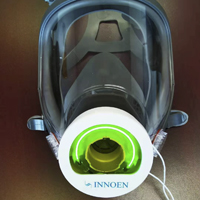The elements of the conventional quarantine system, such as masks, filter respirators, and quarantine hospitals, equivalently face the same challenges with that of the social distancing code. With the accumulations of the staying time of infectious source(s) in a public region, those elements will fail to provide necessary quarantine. They even can become “secondary infectious sources” which accumulate the infected respiratory air leftovers from the primary infectious sources under certain conditions. The root cause is that these elements never reduce or sanitize the volume of infected human respiratory air in a public region. Filtering mechanisms of these devices or procedures will fail while infected human respiratory air in that public region reaches a certain threshold.
The chemical sanitation method is usually applied in quarantine hospitals for sanitizing infection sources. However, it can only deal with hard surface decontamination, quite challenging to deal with infected aerosol in the airflow due to small-sized (<5μm) liquid particle mixing efficiency. Most global COVID-19 casualties come from these unnoticed weaknesses of the conventional quarantine system.






